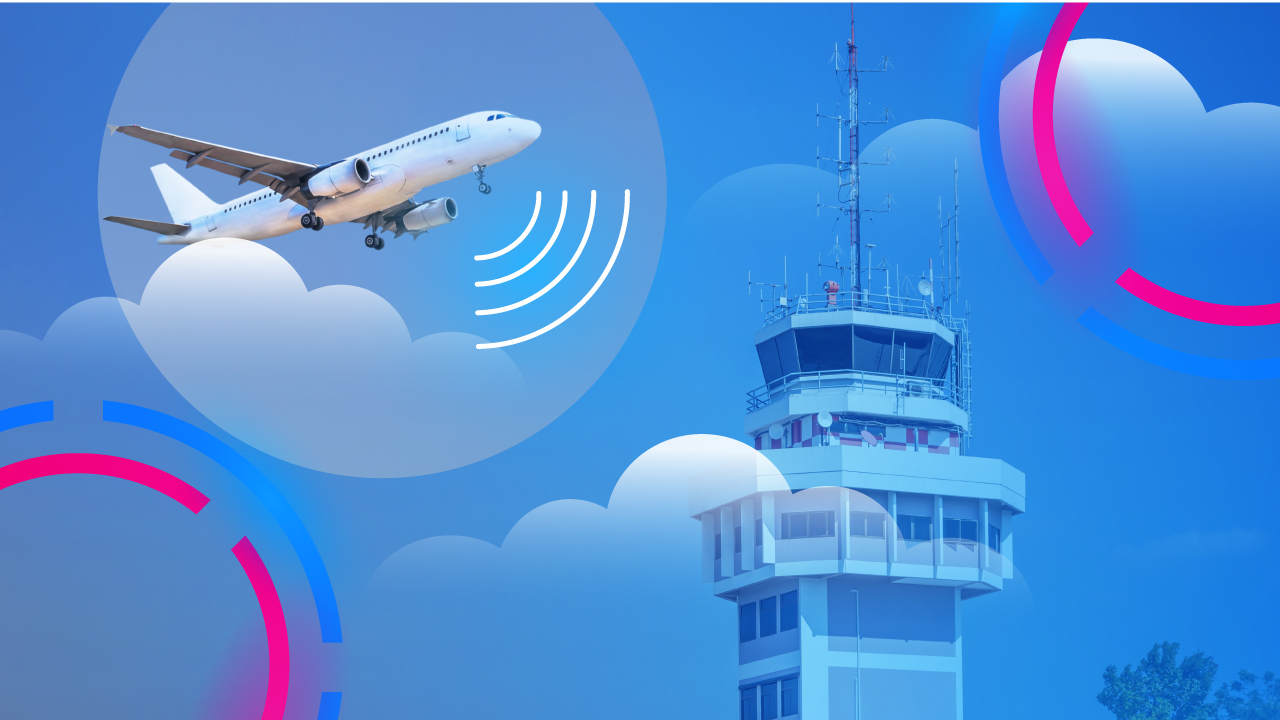Science fiction may make it look like fully autonomous flight is just around the corner, but for now, we’re still relying on human pilots.
And while pilots are incredibly skilled problem-solvers, they’re still human. That means emotions and snap decisions can sometimes get in the way.
In aviation, even the smallest decision matters to safety. So, in this article, you’ll learn about five attitudes that can steer pilots off course and how to spot and correct them.
Let’s start!
Key Takeaways
- Recognizing hazardous attitudes helps pilots make safer decisions.
- Each attitude has signs and antidotes to encourage critical thinking.
- The IM SAFE checklist helps pilots assess their fitness to fly.
- Awareness and self-assessment reduce risks in aviation.
- Identifying these attitudes is crucial for all types of pilots.
Identifying Hazardous Attitudes

Good decision-making is a core skill every pilot learns in training.
Usually, pilots are capable of analyzing a situation and coming up with a sound, rational decision based on their expertise. It is for this reason that air travel remains the safest form of travel until today.
However, pilots are also human. They are vulnerable to emotional outbursts, especially when faced with stressors.
Sometimes it’s because of physical, psychological, or physiological stressors. For whatever reason, there are circumstances that can compromise a pilot’s ability to make good decisions. This is the point where hazardous attitudes start to come up.
The value of knowing and neutralizing these hazardous attitudes is that pilots can identify them early and avoid a full-blown crisis. Pilots can also develop methods to avoid falling into the psychological pit that breeds these attitudes.
The 5 Hazardous Attitudes and Their Tell-Tale Signs
1. Anti-Authority

Attitude: “The rules don’t apply to me.”
There are two sides to an anti-authority attitude.
- The first has to do with an outright resentment of having someone tell them what to do or brushing the rules off as unnecessary.
- The second is a manner of justifying not following the rules, given exceptional circumstances.
It is worth noting that pilots are allowed to question authority if they believe that they are in a justified position. However, questioning the rules is not something that can be done on-the-fly or in the heat of the moment.
The other form of anti-authority behavior comes when the pilot finds a way to rationalize not following the rules.
The common justifications are “I’ve done this hundreds of times before” or “We’re on the clock, and it’s getting late.” In most cases, these involve skipping standard safety practices.
Antidote: “Follow the rules. They are usually right.”
Pilots need to remember that rules were reviewed before they were implemented and used the input of all concerned parties. There is also no excuse for bending the rules, regardless of how much you need to hurry or how skilled you are as a pilot. After all, it only takes one slip-up for an aircraft-related accident to happen.
2. Impulsivity
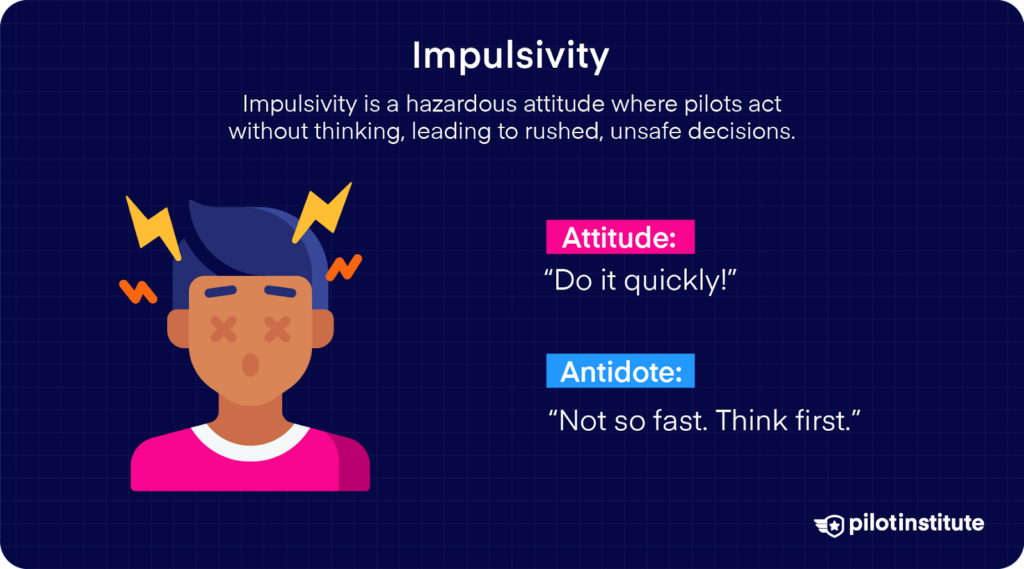
Attitude: “Do it quickly!”
The common stressor for people who display impulsivity is time – or rather, a lack thereof.
Impulsivity is exhibited by hurrying through decisions or situations. This is dangerous as it makes it more likely for pilots to commit to a wrong course of action.
Yes, there are times when decisions have to be made lightning-quick, but pilots are still trained to assess the situation with a calm and clear head.
This ability to maintain composure is even more important in an emergency. Take note that the first decision that comes to mind isn’t always the right one.
Antidote: “Not so fast. Think first.”
“Think first” – that’s the common advice for pilots whenever they are caught in an emergency. Take a deep breath, gather all the necessary information, and come up with the best decision. A correct decision is infinitely better than a quick one.
3. Invulnerability
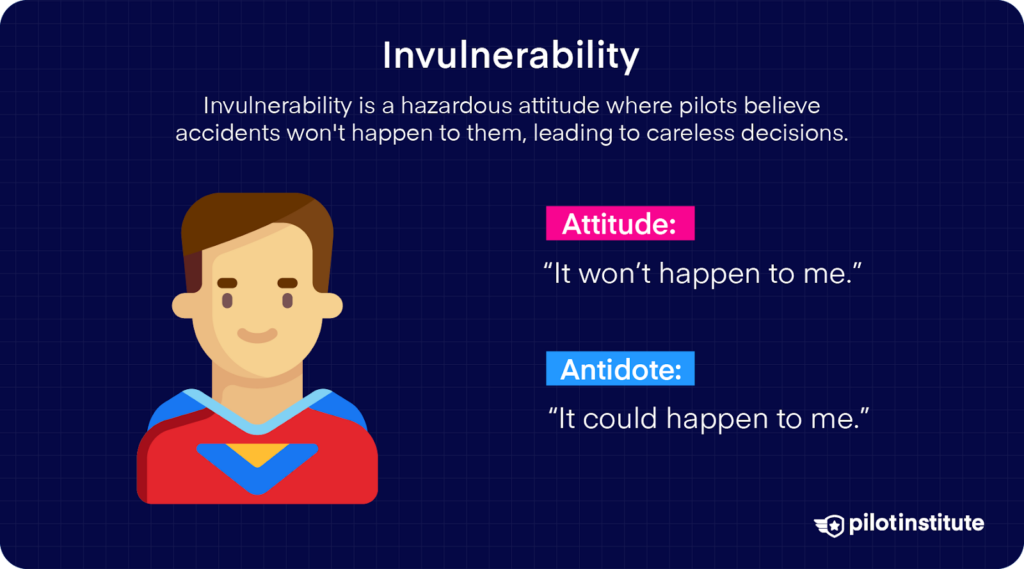
Attitude: “It won’t happen to me.”
People think that accidents happen to other people simply because they are careless or are not fit for the job that they are doing.
In the case of pilots, they need this psychological shield of invulnerability. Without it they get paralyzed with the fear of a crash whenever they climb into a cockpit.
However, a firm belief that an accident will never happen to them also empowers pilots to take more risks than necessary. This tends to go hand-in-hand with other hazardous attitudes, such as impulsivity and acting macho.
Antidote: “It could happen to me.”
Instead, pilots are encouraged to adopt the mindset of “It could happen to me.” Any pilot, no matter how skilled or how much they stick to safety measures, is prone to aviation accidents.
With this mindset, pilots will not take shortcuts on safety checks and reduce risk as much as possible.
Pilots will also avoid rushing through decision-making. They must recognize that one wrong decision may be the trigger to a full-fledged disaster.
4. Macho
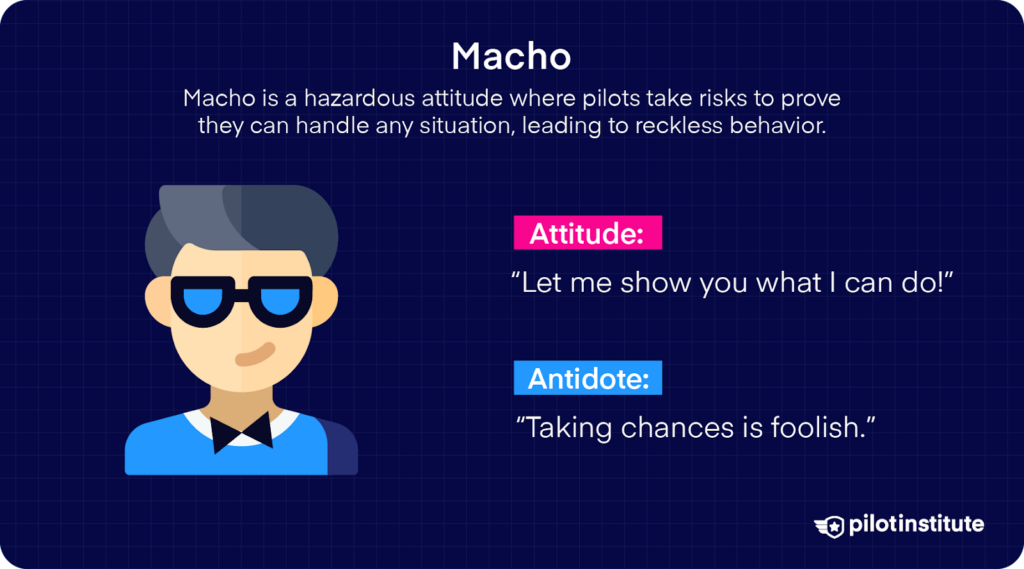
Attitude: “Let me show you what I can do!”
As with any professional field, there is inherent competitiveness in aviation. This is usually not a problem unless pilots start taking unnecessary risks just to prove that they are better than the others.
Despite the macho attitude commonly attributed to male pilots, female pilots are also prone to exhibiting it.
The macho attitude can also snowball from an unchecked and misplaced sense of confidence. To be clear, pilots need to have a certain level of confidence.
After all, they take the welfare of an entire aircraft full of people every time they get into the cockpit. However, this sense of confidence must not develop into risk-taking behavior.
There is also a physiological aspect to exhibiting a macho attitude. The lack of oxygen, medically known as hypoxia, may induce feelings of unfounded well-being. This is a feeling that “everything is going to be alright.” It can lead pilots to overestimate their abilities and do things without recognition of the risks involved.
Antidote: “Taking chances is foolish.”
The macho attitude can be fixed by recognizing that taking unnecessary risks is foolish and goes against their training.
Risking the aircraft and the lives of the people onboard does not make you a better pilot.
5. Resignation
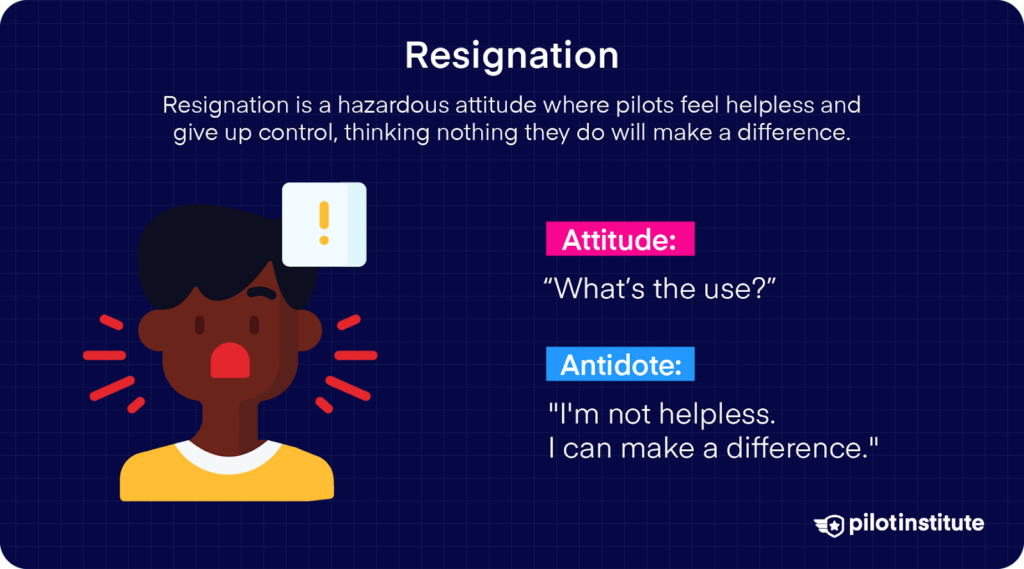
Attitude: “What’s the use?”
A dangerous attitude for a pilot faced with a difficult situation is to just give up and wait for the situation to resolve itself. They may feel that they are not good enough to come up with a solution or are just experiencing bad luck.
Resignation is risky because it makes a pilot give up and accept a bad outcome instead of working to find a solution.
As you can imagine, this is very problematic when there are lives on the line. Resignation can also happen when a pilot is on the receiving end of criticism and does not take it well.
Antidote: “I’m not helpless. I can make a difference.”
The common antidote to resignation is to firmly believe that you can make a difference, no matter how challenging the situation is.
In the face of an emergency, a pilot needs to push through and realize that they are not helpless.
Self-Assessment With the IM SAFE Checklist
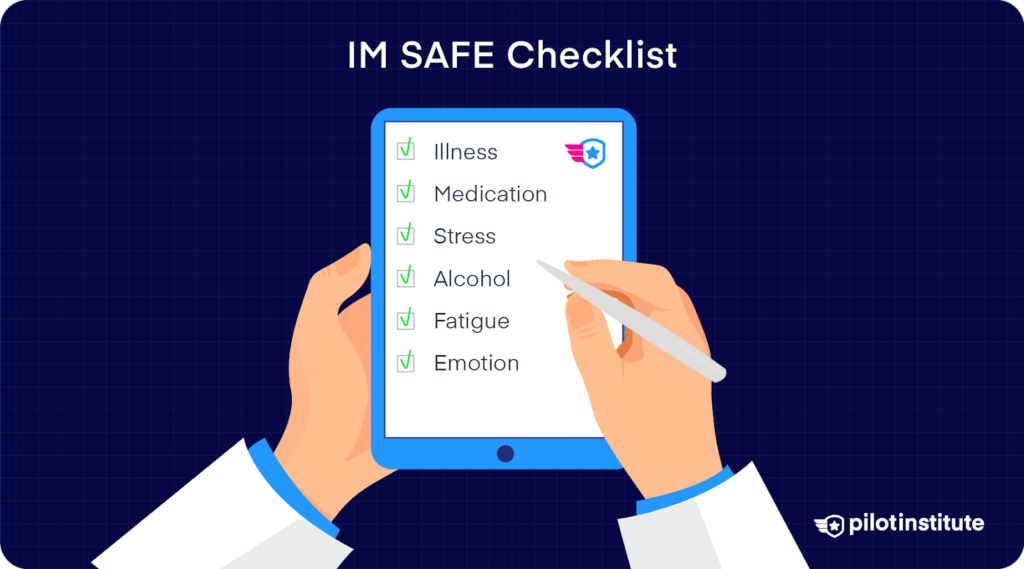
Normally, a trained pilot is expected to avoid these dangerous attitudes and make smart decisions. But under stress, this can change, making it crucial for pilots to stay away from stress whenever possible.
The IM SAFE checklist helps pilots spot early signs that their decision-making might be affected.
These are the items to be considered when doing a self-assessment using the IM SAFE checklist:
Illness
Feeling under the weather to any degree (even a slight cold) can severely affect how a pilot operates an aircraft.
According to FAR 91.3, the pilot alone is responsible for assessing whether they are physically fit before taking control of an aircraft. Should a pilot feel that they are not in good condition to fly, it is always prudent to pick the safer option and not fly at all.
Medication
In some cases, pilots may opt to take medication so that they can continue to fly even with an illness. It is important to ensure that these medications do not, in turn, affect the ability of the pilot to make decisions or operate an aircraft.
The best course of action would be to consult with a medical practitioner or examiner who has an understanding of the situation and can prescribe the appropriate medicine.
Stress
Stress can come in many forms, but it almost always causes a decrease in performance and composure. Whether it’s physical or psychological, a pilot must recognize when they are under extreme stress and seek ways to alleviate this stress or to ask for assistance. Even stress in their personal lives can lead pilots to make errors in the cockpit.
Alcohol
Operating an aircraft within eight hours of drinking alcohol or with blood alcohol levels above 0.4 percent is prohibited under federal aviation regulations. This is a simple matter that all pilots are expected to know.
Even outside the 8-hour window, pilots are advised not to fly if they are still feeling common effects of being drunk, including nausea, lack of focus, or vomiting.
Fatigue
Fatigue is difficult to assess because the acceptable tolerance for fatigue can vary widely from one person to another.
Again, it is up to the pilot to determine if they can function well, considering how much sleep or rest they have had before a flight. Pilots should also be wary of aggravating circumstances such as jet lag or drastic shifts in day-to-night schedules.
Emotion
Just as important as a pilot’s physical health is their emotional state. Despite any level of training, pilots are still human and can still be compromised by a heavy emotional toll.
Although emotions can be subdued temporarily, they can resurface unpredictably and lead to poor decision-making. It is up to the pilot to determine if they are emotionally stable enough to operate an aircraft.
Conclusion
Even with our flaws, humans are still the best pilots out there.
Part of your training as a pilot is to recognize these behavior patterns and make sure they don’t get in the way of good decision-making.
The five hazardous attitudes and the IM SAFE checklist are powerful tools to help you spot behaviors that might cloud your judgment.
If you’re a private pilot, recreational pilot, or even a drone pilot, knowing these by heart helps you catch issues early.



